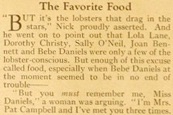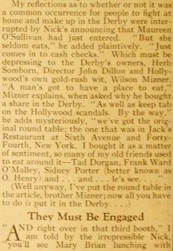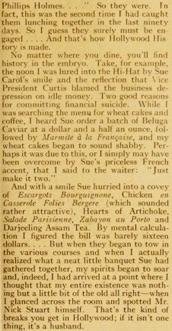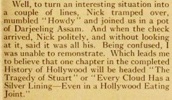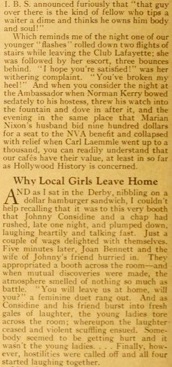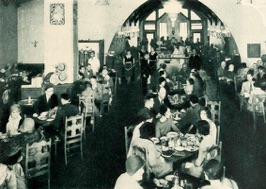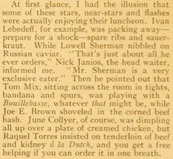City Lights 1930 1931 1932 next previous
City Lights Clippings 182/387
Hale Horton, Motion Picture, New York, February 1931.
City Lights Scene, Henry Bergman as Mayor
& Here is the outside of Henry‘s, distinctive Hollywood eating emporium, and here is Henry (Bergman) himself, in person.
(...) Talking Screen, Aug. 1930
& Everybody goes to Henry‘s – the stars, the near stars,
the extras, the sightseers – says Mr. McInyre. It is
noisy but it has a bonhomie that few eating places have
achieved. Henry was a character actor and his
restaurant is reputed to have been backed by Charlie Chaplin.
(...) New Movie, Dec. 1930
& Above you have the pleasure of peeing at the interior
of Henry‘s. It‘s not a dancing place, there isn‘t
even any music. But every night lots of studio folk gather
to eat there and discuss this and that till the wee
hours. Lois Meran can be seen in the left foreground.
(...) Talking Screen, Aug. 1930
& Where They Eat... and Why
A Short Menu History Of Hollywood
By Hale Horton (...)
Strange groupings I noticed in all the restaurants from
Victor Hugo‘s to Stark‘s, whose German food causes
Hollywood moguls to mingle with orchestra leaders. At Henry‘s
I found sad-eyed song writers doping out new musical
spasms; Charlie Chaplin, dunking a jelly sandwich in a concoction
of coffee and tea, while he patiently explained his stand
against the talkies.
(...) Motion Picture, Feb. 1931
„To space the laughs“
Editorial content. „SAVING THE LAUGHS
Directors of movie comedies that depend upon action,
principally, await with much interest the verdict on
Chaplin‘s experiment with ,silent‘ pictures. The greatest
difficulty faced by the director, according to Del
Lord, who has made some of the best, is to space the laughs.
That is because the audience is an unknown quality.
If the action is slowed down to give the audience time to laugh,
the members of that particular theater crowd may not
laugh and a deplorable ,wait‘ results. Within the past few
months comedy directors have been cutting short
the ,spoken titles‘ in the hope of obviating this. If the people
will accept pantomime, combined with the ordinary
sound effects, such as street noises, directors see a chance
for a return to the rapid-action comedy that lost some
of its zip through the talkies. The stage comedian has an
opportunity to space his laughs that is denied to the
screen actor.“
Redaktioneller Inhalt
City Lights 1930 1931 1932 next previous

